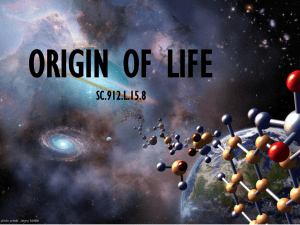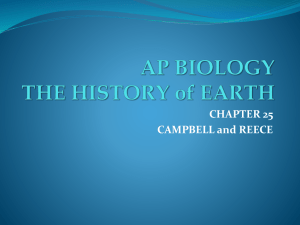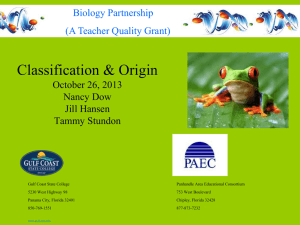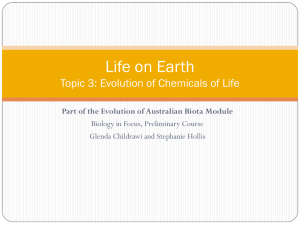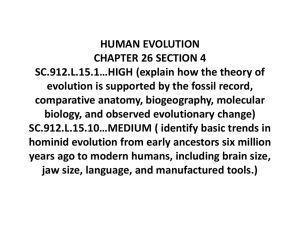The Beginning of life on Earth
advertisement
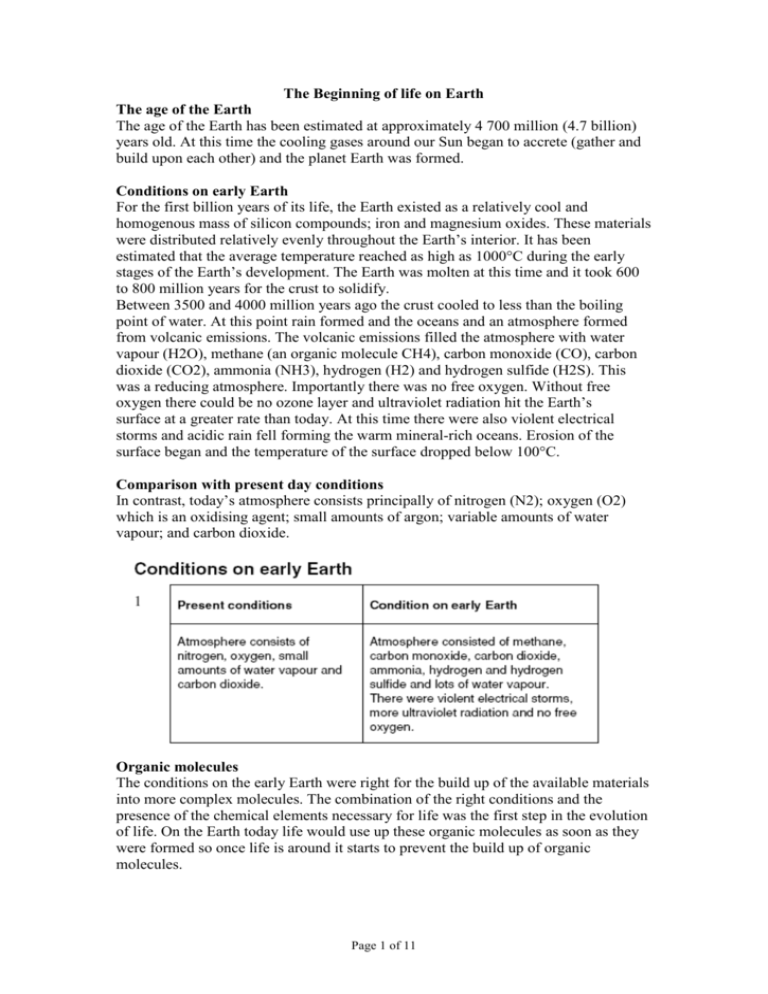
The Beginning of life on Earth The age of the Earth The age of the Earth has been estimated at approximately 4 700 million (4.7 billion) years old. At this time the cooling gases around our Sun began to accrete (gather and build upon each other) and the planet Earth was formed. Conditions on early Earth For the first billion years of its life, the Earth existed as a relatively cool and homogenous mass of silicon compounds; iron and magnesium oxides. These materials were distributed relatively evenly throughout the Earth’s interior. It has been estimated that the average temperature reached as high as 1000°C during the early stages of the Earth’s development. The Earth was molten at this time and it took 600 to 800 million years for the crust to solidify. Between 3500 and 4000 million years ago the crust cooled to less than the boiling point of water. At this point rain formed and the oceans and an atmosphere formed from volcanic emissions. The volcanic emissions filled the atmosphere with water vapour (H2O), methane (an organic molecule CH4), carbon monoxide (CO), carbon dioxide (CO2), ammonia (NH3), hydrogen (H2) and hydrogen sulfide (H2S). This was a reducing atmosphere. Importantly there was no free oxygen. Without free oxygen there could be no ozone layer and ultraviolet radiation hit the Earth’s surface at a greater rate than today. At this time there were also violent electrical storms and acidic rain fell forming the warm mineral-rich oceans. Erosion of the surface began and the temperature of the surface dropped below 100°C. Comparison with present day conditions In contrast, today’s atmosphere consists principally of nitrogen (N2); oxygen (O2) which is an oxidising agent; small amounts of argon; variable amounts of water vapour; and carbon dioxide. Organic molecules The conditions on the early Earth were right for the build up of the available materials into more complex molecules. The combination of the right conditions and the presence of the chemical elements necessary for life was the first step in the evolution of life. On the Earth today life would use up these organic molecules as soon as they were formed so once life is around it starts to prevent the build up of organic molecules. Page 1 of 11 Simple organic molecules Complex organic molecules, such as those that make up your body, are made from simpler organic molecules. These simple organic molecules contain the elements carbon, hydrogen, oxygen, nitrogen with smaller amounts of phosphorous and sulfur. They are known as the building blocks of life and consist of: • amino acids • nucleic acid bases • sugars and • phosphoric acid. All of these molecules are organic molecules (the chemicals in living systems.) Amino acids consist of a basic structure containing nitrogen, carbon, oxygen and hydrogen. They are commonly referred to as the building blocks of life because they combine in different arrangements to form different types of proteins. Proteins in turn are responsible for the formation, repair and function of all cells in living organisms. There are only 20 different amino acids and these are assembled into thousands of different proteins. The human body, for example contains about 150 000 different proteins. Sugars are very important in the formation of nucleic acids such as RNA and DNA. These are formed when sugars link with phosphates to form a nucleotide with a nucleic acid base. How does the knowledge of the chemistry of living organisms relate to the conditions of early Earth? The molecules produced in a reducing atmosphere, such as the early atmosphere, form the basic elements of living cells: membranes, proteins, RNA and DNA. So for life to arise you needed an atmosphere that existed on Earth millions of years ago. The next step in the origin life is for the simple organic molecules to build up to more complex organic molecules. That is, amino acids into proteins and nucleic bases, sugars and phosphoric acid into DNA and RNA. This is sometimes called chemical evolution. But for this to occur where did the organic molecules come from? Organic molecules in the cosmos There are two possible sources for organic molecules. They can be: • made on the Earth from simpler molecules • arrive from space on meteorites. Earth is not the only place in the cosmos (Universe) where organic molecules have been found. Astronomers and biologists agree that the key elements or molecules required to initiate life may have arrived in meteorites. This is the theory of Panspermia (meaning seeds everywhere.) Certain types of meteorites called carbonaceous chondrites contain a variety of carbon-rich compounds. It has been suggested that it may be possible for these compounds to form shapes similar to simple organisms. A chondritic meteorite that fell to Earth in South Australia in 1969, has been found to contain amino acids. Some of the rock samples from Mars arguably contain fossils of bacteria. The presence of these elements is not enough to sustain life or form organic molecules. This is evident from the fact that most of these elements have been found on the Moon, yet no life has been detected. It was the particular conditions found on the Earth especially the presence of liquid water that allowed for chemical evolution to occur. It does however lead to the fascinating prospect of life originating in other parts of the cosmos and evolution producing organisms vastly different from the life forms on this planet. Page 2 of 11 Theories about the evolution of life The chemicals for life were available and organic molecules could build up on the early Earth but more than this is required for life to form. How did life start? Here are some theories. Spontaneous generation During the Middle Ages it was believed that living organisms could arise spontaneously and survive to replicate or even transform from other living things. This appearance of life was called spontaneous generation. This theory was well supported in the Middle ages using the transformation of caterpillars into moths or butterflies, tadpoles into frogs and maggots emerging from decaying matter as examples to justify this belief. Scientists began to question this theory. However, it was not until Louis Pasteur (1822-1895), a French scientist, provided evidence to show conclusively that this was not the case. Louis Pasteur performed experiments to demonstrate that life did not spontaneously generate from non-living materials. However just because life doesn’t arise spontaneously now does not mean that it did not happen during the time of chemical evolution on the early Earth. Synthesis of organic molecules It is very difficult to recreate the conditions that would have been present on the Earth at the time of its formation. However scientists have tried, through experiments, to create the conditions that prevailed at the time. There are three views on where life developed on the early Earth. These are: • tidal pools producing froth • Panspermia • deep-sea thermal vents (black smokers). Some of the experiments that were carried out to illustrate the possible mechanism for the formation of simple organic molecules are outlined below. Charles Darwin had speculated about the possibility of life originating in warm, phosphate-rich water, however this was not seriously pursued until earlier in the 20th century. Haldane and Oparin J B S Haldane, a Scottish biochemist, and A P Oparin, a Russian scientist began working on the possible theories for the formation of organic molecules. Haldane and Oparin proposed that soon after the formation of the Earth, the conditions were very different from the present, as mentioned earlier. These conditions were thought to be suitable for the precursors of living molecules (amino acids, sugars and nucleotide bases), to form from the hydrogen based molecules of ammonia, methane and water. The formation of these precursor molecules was possible due to the absence of oxygen and an abundance of energy from electrical discharges (lightning), ultraviolet light, heat and radiation. There were no organisms present to destroy the spontaneously formed molecules, so they were able to accumulate in the water (‘seas’) present. Haldane and Oparin suggested that continued synthesis and increasing concentrations led to the formation of polypeptides from amino acids and eventually to a diverse range of molecules including enzymes and other proteins. Page 3 of 11 Oparin continued to work on what was called the heterotrophic hypothesis, in 1924. This hypothesis was based on the premise that the first organisms were heterotrophic, meaning they obtained their organic material from the environment, rather than producing it like an autotrophic organism, such as cyanobacteria (previously known as blue-green algae.) Oparin went on to describe the idea of a reducing atmosphere in which it is possible to produce organic compounds. A reducing atmosphere is one that contains methane, ammonia, hydrogen and water. Such an atmosphere was thought to have been present on early Earth. This theory was not tested until the middle of the 20th century. Urey and Miller In 1953, S L Miller and H C Urey, who were both chemists, carried out an experimental simulation of the primitive conditions proposed by Haldane and Oparin. The device used (pictured below) circulated a mixture of steam (water vapour), ammonia, methane and hydrogen through liquid water forming a solution. This mimicked the conditions on the early Earth. A high-energy electrical discharge (to represent the frequent lightning) was sparked through the solution forming a number of amino and hydroxy acids, which are vital components or building blocks of living things. After a few days organic compounds such as amino acids could be collected. These compounds were obtained only when oxygen gas was not present in the reacting vessel. Page 4 of 11 The results of Urey and Miller’s experiments have lead to further research and experimentation by other scientists. It is an important experiment because it shows that amino acids can be produced by more simple raw materials. The relevance of Urey and Miller’s experiments have been questioned, as it is thought that the experimental atmospheric conditions used may not be a true reflection of those that existed on the early Earth. This had lead to other scientists trying different combinations of raw materials and using ultraviolet radiation as a source of energy. This has resulted in building different amino acids. The nature and practice of Science The experiment of Urey and Miller illustrates the nature and practice of Science. Science is self-correcting. The knowledge available is used to form a hypothesis. When errors are found through new knowledge a new hypothesis is formed that accounts for the new information. What is believed to be true at the moment may be different in two years time. Over time Science corrects its mistakes and builds stronger understandings of the world. Religions differ form this because they are not self-correcting and rely on faith. During the Middle Ages when it was thought that rats where made by rubbish and maggots came from rotten meat (spontaneous generation) there was no experimentation to test this idea it was accepted by everyone. In contrast to this Urey and Miller set out to find an answer by observation and experimentation. Since Urey and Millers’s experiment there have been further experiments and different theories for the origin of life have occurred. Technological advances As new technology becomes available there is a development in the understanding of the origin of life and evolution of living things. As it became possible to identify chemicals and molecular structure this gave evidence to support the action of organic compounds. Other changes in technology have made it possible to accurate date fossils and piece together a more complete picture. These include: • electron microscopes • spacecraft • deep sea exploration vessels • carbon dating • molecular clock. Electron microscopes The invention of the electron microscope has meant that microfossils within rocks can now be seen. This has extended the evidence of live on Earth and also may identify fossils from other planets. Spacecraft Sending spacecraft to other planets makes it possible to examine conditions on these planets to compare to the conditions on early Earth. Deep sea exploration vessels The presence of deep-sea vents was unknown until vessels were developed that could travel to the depths of the oceans. Once this occurred it was discovered that there were many unknown organisms living on the vents and using the energy from the vents as a basis for an ecosystem. Page 5 of 11 Radioactive carbon dating When rocks are dated, their ages are referred to as either numerical or relative. Numerical age refers to a specific number of years, such as 200 million years ago (mya). Numerical age is sometimes called absolute age. Relative age provides a comparison between rocks, in other words it states whether one rock formation is older than another rock formation. The numerical age of a rock comes from the decay of radioactive isotopes, resulting in new (daughter) isotopes that are more stable. This process of change is called radioactive decay. The unstable radioactive element is also called the parent material, and the stable non-radioactive element produced from the decay of the parent material is known as the daughter product. Therefore uranium will decay to lead and potassium will decay to argon. Using the known behavior of many isotopes, the age of rock can be calculated using two methods: • counting the number of new (daughter) isotopes • using the known decay rate to calculate the length of time required to produce a specific number of new isotopes. Another way of determining the numerical age of rocks is by using carbon-14 (an isotope of the element carbon). It is a radioactive isotope that is continually produced in the atmosphere by the action of cosmic rays breaking down atmospheric nitrogen. The carbon combines with oxygen to form carbon monoxide or carbon dioxide. It is then absorbed by living things, so that all living things containing some carbon-14. While an organism is alive, the decaying radiocarbon is continually replaced. This means that the ratio of carbon-12 to carbon-14 remains constant. When the organism dies, the amount of carbon-14 decreases as it decays into nitrogen-14. The age of a sample is derived by comparing the proportions of carbon-12 to carbon-14. This method of dating has been adopted for determining the ages of samples from the last small fraction of geologic time as the amount remaining eventually is too small to determine. The molecular clock Another technological advance that has had a huge impact on scientific thinking is the molecular clock. Biologists use a number of molecules, such as DNA, to determine similarities and differences between organisms. The differences in the molecules can be said to measure how long the organisms have been evolving independently of each other. This method of comparison assumes however, that the rate of molecular change is constant and measurable. These claims are based on the assumption that the molecular clock, the rate of genetic change any given species undergoes, is relatively constant over time. Thus, a measurement of the genetic difference between any pair of species would reveal how long ago their ancestral lineages went their separate ways.. Page 6 of 11 Exercise 1.1: Organic molecules and life a) Describe the conditions on the early Earth at the time that chemical evolution of organic molecules was occurring. _____________________________________________________________________ _____________________________________________________________________ _____________________________________________________________________ _____________________________________________________________________ b) For life to begin there must be a supply of organic molecules. Name two possible sources of organic molecules. _____________________________________________________________________ _____________________________________________________________________ c) Using scientific information present one argument to support and one argument to refute the statement below: ‘Life on Earth came from outer space.’ The statement can be supported _____________________________________________________________________ _____________________________________________________________________ The statement can be refuted because _____________________________________________________________________ _____________________________________________________________________ d) Organic molecules have been found on meteorites arriving on Earth. What are the implications of the existence of organic molecules in the cosmos for the origin of life on Earth? _____________________________________________________________________ _____________________________________________________________________ _____________________________________________________________________ _____________________________________________________________________ _____________________________________________________________________ Exercise 1.2: Synthesis of organic molecules 1 Two scientific theories relating to the evolution of the chemicals of life and the synthesis of organic molecules come from Haldane and Oparin and Urey and Miller. Discuss the significance of both of these theories to the understanding the origin of life on Earth. Haldane and Oparin _____________________________________________________________________ _____________________________________________________________________ _____________________________________________________________________ _____________________________________________________________________ _____________________________________________________________________ _____________________________________________________________________ _____________________________________________________________________ Page 7 of 11 Urey and Miller _____________________________________________________________________ _____________________________________________________________________ _____________________________________________________________________ _____________________________________________________________________ _____________________________________________________________________ _________________________________ 2 Using information in this part and additional material you have gathered from secondary sources analyse the experiments of Urey and Miller. a) What was the reason for their experiments? _____________________________________________________________________ _____________________________________________________________________ _____________________________________________________________________ ______________________________________ b) Outline the result of their experiments. _____________________________________________________________________ _____________________________________________________________________ _____________________________________________________________________ ______________________________________ c) How do the Urey and Miller experiments differ in application of the nature and practice of science, compared to theories such as spontaneous generation proposed in the Middle Ages? _____________________________________________________________________ _____________________________________________________________________ _____________________________________________________________________ _____________________________________________________________________ d) How do Urey and Miller’s experiments aid understanding about the possible origins of life? _____________________________________________________________________ _____________________________________________________________________ _____________________________________________________________________ _____________________________________________________________________ Exercise 1.3: Technological advances How has technology assisted in understanding the origin of life and evolution of living things? _____________________________________________________________________ _____________________________________________________________________ _____________________________________________________________________ _____________________________________________________________________ _____________________________________________________________________ _____________________________________________________________________ _____________________________________________________________________ Page 8 of 11 Below is the theory of one Australian scientist based on recent information. Where life originated The theories on where life originated come down to two. It either originated external to the Earth or it originated on the Earth. The evidence for the external origin comes mainly from the location of organic molecules in chunks of rock known as meteorites that have been found on Earth’s surface. No one seriously suggests that life ever existed on these chunks of rock, only that organic molecules somehow or other were produced on these chunks of rock by chemical processes. These extraterrestrial organic molecules are always small molecules. The type called building block sized molecules. Strangely these same chunks of rock also suggest that the big chunk of rock known as the Earth probably had organic molecules present as a result of its formation and chemical processes occurring on its surface layer. Similar chemical processes would therefore have operated to ensure the presence of small organic molecules on a primitive and lifeless Earth. Nobody ever disputes the idea that the surface of the early Earth was an unpleasant and hostile place. The chance of organic molecules being given time and stability to join together into the larger structured molecules and to approach a size required favour the creation of life on the nprotected surface of the Earth was almost certainly not good. The protective feature of the atmosphere was under constant assault, being blown away almost entirely on numerous occasions by the constant bombardment of extraterrestrial objects during the days of the Early Solar System. The stability of the exposed surface was low. The atmosphere was reactive; rain was almost certainly constant near coasts and would have been rare inland with no mitigating climate controls as provided by life today. The atmosphere was not able to protect from the UV rays emitted by a young more dense hotter Sun. Damage to organic molecules forming at the surface would have been horrendous. Mutations were not a possibility at this time, they only occur after the evolution of life. Few if any environments other than hot springs on the surface would have been able to supply the constant chemical and physical raw materials necessary to allow the production of life molecules or life. The physical barrier of distance in a hostile environment would mean if life evolved in a hot spring it was trapped, unable to make it easily to an adjacent hot spring. The problem was building the precursor molecules able to be spontaneously assembled into an order called life. Time was essential. The life of most hot springs is short in a geological sense. For that reason the most probable location for the initial growth of the precursor life molecules was deep in the protective cover of the ocean. Luckily deep-sea exploration now confirms the existence of chemosynthesis as a life supporting mechanism especially around sites of active volcanism. The deep sea food webs are well documented, photographed and the subject of intense study. That’s sexy science. On the frontier of knowledge, evasive and therefore desirable. A challenge. The similarity of life across vast separation distances also clearly shows that the ocean enables the movement of life from one hot spring to another under the protection of the ocean. The question arises then was it possible for conditions to exist at the ocean depths that would enable life building molecules to come into being at the bottom of an ancient ocean. The answer not surprisingly is yes. Life is made up of larger molecules built from smaller molecules. You are no different to any other life form. You are made up of large molecules built from smaller molecules produced through digestion of larger molecules to form those small molecules which are then used to make up required larger molecules using a template. That template has the name DNA, a self- Page 9 of 11 replicating molecule. Without the organic template nature would have had to develop its own template from an inorganic source. The most likely template was a clay mineral. Clay minerals and the precursor feldspar minerals that weather and are hydrated to form them abound on the floor of the ocean. The ocean floor is predominantly basalt rock rich in feldspar. The opportunity for the feldspar to weather and form clays is constant. The eruption of small organic molecules dissolved in water is constant from deep-sea volcanic vents. The presence of ammonia necessary for the formation of amino acids is guaranteed in such environments. The solution of this mix of dissolved chemicals is a guarantee that the molecules will come into contact under high pressures due to ocean depth and high but not excessive, temperatures. Put that mix of chemicals near a clay inorganic template where the catalysis of larger building blocks of life could occur in the constant presence of active catalysts such as copper, nickel and platinum group elements erupted from volcanic vents in the solutions of hot water and you have an ideal recipe to build organic molecules that are larger and new. These physical conditions are all documented to enhance chemical reaction that can lead to the growth of new organic molecules spontaneously because of the chemistry. The question of time arises. How long did the evolution of organic molecules and life take? How many failed attempts. The answer is probably an astronomical number of attempts in a huge number of locations simultaneously. No one expects that life evolved rapidly from an organic soup. Almost everyone could imagine that an extended period of time during which protection from hostile conditions near the surface of the Earth would be required to allow life to begin. Life also does not remain stuck on the bottom of the ocean. It currently occupies a diverse range of environments. Once evolved it required a mechanism to slowly rise toward the surface from its deep sea cradle. The obvious choice of slowly bringing life to the surface while maintaining its contact with the volcanic vents supplying its energy source is a hotspot volcano environment. In the primitive Earth volcanism across the surface was much more common that today. The Earth was venting excess heat produced from its formation. Much of that volcanic activity was probably erupting from hotspots, volcanoes slowly over millions of years reaching for the surface of an already formed ocean from the bottom of the sea. Life simply originated on the sides of such a volcano where conditions were optimal and was brought to the surface by geological processes. Plate tectonic processes ensured life’s distribution was global and eventually covered the entirety of the planet. The slow rise of a volcano from the depths and its equally slow retreat back to ocean depths as the volcano moved off the hotspots ensured that any life evolved on the sides of that volcano was given ample time to evolve to suit changing conditions. Selection was inherent in life from the beginning. A slowly evolving environment ensured life diversity and a variety of habitats. The longlife of hotspots in today’s oceans ensures that similar volcanic chains in ancient oceans provided many opportunities for life to jump from one mature volcano to the juvenile volcano next to it in the sub sea chain before the repeating of that volcano’s struggle to reach the surface. The repetitive cycle of sea mountain building and decline put life on the entire surface of the Earth. Dr Ric Morante 05/05/2003 ©LMP Page 10 of 11 Page 11 of 11

